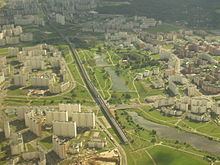Type Rapid transit Ridership 17.70 million (2012) Owner Moskovsky Metropoliten Locale Moscow | System Moscow Metro Opened December 27, 2003 Electrification Third rail Stations 7 | |
 | ||
Termini Bittsevsky Park (northern)
Buninskaya Alleya (southern) | ||
Moscow lightrail butovskaya line
Butovskaya Line (Russian: Бу́товская ли́ния, [ˈbutəfskəjə ˈlʲinʲɪjə]) is a line of the Moscow Metro.
Contents
- Moscow lightrail butovskaya line
- Moscow metro butovskaya line of light metro
- Rolling stock
- Recent developments and future plans
- References
The line represents an experiment in building rapid-transit in areas where tunnel boring is considered expensive and impractical. In the past, attempts were made to build lines at ground level, however as the Filyovskaya Line showed, harsh Russian winters and the occupation of the large amount of useful land, make such projects impractical. However, new districts on the very edge of the city, particularly those outside the Moscow Automobile Ring Road (MKAD) required a rapid-transit connection. As the practicality of tunnel boring is unclear, the system was planned to be above ground since the late 1980s, when Moscow Metro design bureau, Metrogiprotrans, developed a set of projects that would bring rapid-transit beyond MKAD, with the Yuzhnoye Butovo District being the first one.
The term Light Metro (Лёгкое метро́) was applied to these new projects, as it would feature a continuous elevated structure. Special rolling stock had to be developed to serve the line, as it would have to be resistant to the harsher climate elements and be able to negotiate sharper curves. For ease of operation, the Light Metro was integrated into the conventional Metro service.
The Butovskaya Line essentially extends the Serpukhovsko-Timiryazevskaya Line beyond the Serpukhovsky terminus. The 5.6 kilometres (3.5 mi) line was opened on December 27, 2003. The first 1.6 kilometres (0.99 mi) were bored in a tunnel, which allowed for a convenient transfer connection at the Bulvar Dmitriya Donskogo terminus. For the rest of its length it is elevated, with both single and double tracks protected by a sound barrier. Currently four elevated stations, each of identical design, are in operation. All of them except Ulitsa Starokachalovskaya have a lift for wheelchair users only. The line interchanges with Line 9 at Ulitsa Starokachalovskaya and Line 6 at Bittsevsky Park.
Moscow metro butovskaya line of light metro
Rolling stock
The line shares the Varshavskoe depot (№ 8) with the Serpukhovsko-Timiryazevskaya Line. Specially built class 81-740/741 (Rusich) trains serve this line. These were designed for outdoor operation. A total of 12 three-car trains are currently assigned.
Recent developments and future plans
Although the Light Metro was indeed innovative, it also received its share of criticism from different social groups and the media, which could well affect its future.
The main problems arose from finances, as the design was originally planned to be cost-saving; however, the BLLM turned out to be more expensive than conventional Metro lines. Passenger discomfort arose from shorter trains and larger intervals, but in particular from the transfer at Ulitsa Starokachalovskaya/Bulvar Dmitriya Donskogo, where the Light Metro station consists of two separated platforms on either side of the main line with no reversal sidings behind it. As a result, passengers must queue for lengthier times at a platform and also deal with exiting traffic before boarding their train. Additional problems arose from the landscape damage done by the flyover bridge.
Furthermore, costly and embarrassing improvements had to be made just a few months after opening. First, improvements had to be made to the faulty new trains, as they required immediate and unforeseen refits; in addition, despite the sound barriers, further noise reduction works had to be carried out on the tracks themselves by repairing their joints.
Despite the criticism, the Moscow Metro continues to put forward several expansion programs for the BLLM, the first one of which is to place proper reversal sidings north of the station thus separating the terminus platforms into northbound and southbound roles; at present this is announced for 2010. After the completion of that there was initially a planned northwestwards underground extension towards the terminus of the Kaluzhsko-Rizhskaya Line, Novoyasenevskaya with two new stations: Lesoparkovaya and Bittsevsky Park, which opened on February 27, 2014. Since then Moscow Metro has postponed the project and even taken it off its list of primarily projects to be completed by 2015.
A further three-station expansion to the southeast, as Butovo continues to grow, is proposed: Ulitsa Staropotapovskaya, Ulitsa Ostafyevskaya and Novokuryanovo, along with a new depot. The latter's construction might prove pivotal as it would allow for the line to become more independent in operation. On the map of new plans, the extension to Milizeysky poselok (or East Sherbinka) is planned with at least two stations.
The problems with the Butovo Line have also affected the prospect of other Light Metro lines in general as the second planned line, the Solntsevskaya Light Metro Line, has now been canceled. Its construction was planned to begin in 2004, with the line expected to open in 2006, but after repeated postponements, Moscow Metro decided that it would be more practical to revert to an older project — a conventional, Solntsevskaya Line. After the SL's cancellation, there have been concerns that BL's fate could be much worse, as there are arguments that it would be more practical to disassemble the line and replace it with two-three station extension of the STL.
Despite the shortcomings, one positive aspect of the BL is that the 81-740/741 trains, serial production of the rolling stock, have gained wider usage and are now dominant on the Filyovskaya Line, having replaced all of the older trains and is now growing its share of the Arbatsko-Pokrovskaya Line.
